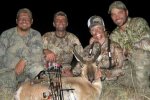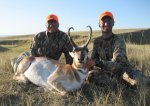Questions for Mike E. and Other Antelope Gurus re: Antelope Behavior & Scouting Trip
My brother-in-law and I were looking to hunt a new area this year due to the declining antelope numbers across most of South Dakota where we have archery hunted the past 2 seasons. Last weekend we spent a day-and-a-half looking for our continent’s fastest land mammal. Needless to say, we were more than pleasantly surprised when we encountered 600-700 of them in this short period (FYI – 90% of these were on public land)!
When we would find an antelope we marked it on my GPS; gave it a special reference code for the GPS waypoint; recorded this waypoint into a journal and took notes on its features, rough score, behavior, what it was doing, where we thought it was headed to/coming from, time of sighting, etc.; then I would take a picture of the antelope with my digital camera/spotting scope. Now we are transferring this information to maps and re-naming each digital photo with the special code for each waypoint so we have a visual reference and GPS location to each antelope so we can put together a game plan before the archery opener. Of the 600-700 antelope we saw, we marked and made notes detailing about 105 bucks (no duplicates). Of these bucks, and using Mike’s 4x7 scoring system, we estimated that a majority of them were Pope and Young, with several in the 70-75” range. I don’t think we saw one that quite pushed 80” though.
Alright, there’s a little background to precede a few questions I have for you guys based on the behavior of the speed goats we saw this weekend (sorry this is a bit lengthy...feel free to answer just certain questions if you want).
The first question I have, or at least observation that we made, was that the largest bucks were either by themselves or with harems of does that contained no other bucks. We saw many bachelor groups of bucks as well, but a lot of these groups consisted of smaller bucks and maybe a few nicer ones mixed in every now and then. These groups numbered in quantity of 5, 7, and even 14 bucks (and a few in between). I guess my question would be that is it typical for larger, more dominant bucks to isolate themselves this time of year and in some cases already be gathering their harems? This was August 6th and 7th when we observed this. Also, of these bachelor groups, will all the bucks stay in the same general area over the fall or will they spread-out much? Will the larger bucks stay in the same area?
The second question is that when we spotted the bucks, a lot of them, and probably mainly the more dominant and larger ones, would make scrapes in front of us. They knew we were there so was that a way of showing aggression towards us to “protect” their harem” or were they just nervous? Most of the time this occurred when there were other does around. They would paw at the ground and then make droppings where they just scraped. Is this common this time of year?
The last question I have is that the area that we scouted consists of 95%+ of grassland and pastures (like most antelope country), but there are a few small alfalfa hay fields and some cut grass hay fields (round hay bales are still sitting in some of them). It seemed that we would find antelope in these areas, especially early morning and evenings. I know they probably use this as a feeding area but I also know they feed on the taller, uncut grass as well. I did spot some of the antelope bedded right in the alfalfa in the middle of the day so I am uncertain if they were bedded there or feeding there? Maybe both at the same time? If I were looking to setup a ground blind, when can I expect the antelope to feed, bed, and water? I am uncertain if they also bed in these fields? Do antelope feed all night? I know they feed throughout the day and water in the day because of their small stomachs. How and when do I hunt this area and get in and out without spooking the antelope? What times of day and night do they generally a) feed, b) bed, and c) water? Any more insight on this would be extremely helpful.
Also, I have attached a few pictures of the antelope we spotted. Feel free to give your best guesses on their scores if you want or just look take a peek for your enjoyment! The picture file name format is “AB*-11” where the “*” is the number of the buck so you can see which pictures are of the same buck. Also, these are in my personal album “2011 Antelope Scouting” if you want to see additional photos since I can only upload 5 per post. Thanks a lot guys for your responses in advance! Good luck this fall!
John
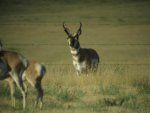
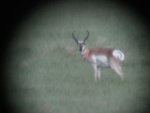
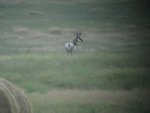
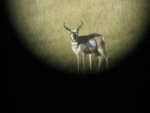
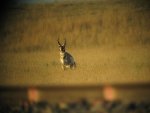
My brother-in-law and I were looking to hunt a new area this year due to the declining antelope numbers across most of South Dakota where we have archery hunted the past 2 seasons. Last weekend we spent a day-and-a-half looking for our continent’s fastest land mammal. Needless to say, we were more than pleasantly surprised when we encountered 600-700 of them in this short period (FYI – 90% of these were on public land)!
When we would find an antelope we marked it on my GPS; gave it a special reference code for the GPS waypoint; recorded this waypoint into a journal and took notes on its features, rough score, behavior, what it was doing, where we thought it was headed to/coming from, time of sighting, etc.; then I would take a picture of the antelope with my digital camera/spotting scope. Now we are transferring this information to maps and re-naming each digital photo with the special code for each waypoint so we have a visual reference and GPS location to each antelope so we can put together a game plan before the archery opener. Of the 600-700 antelope we saw, we marked and made notes detailing about 105 bucks (no duplicates). Of these bucks, and using Mike’s 4x7 scoring system, we estimated that a majority of them were Pope and Young, with several in the 70-75” range. I don’t think we saw one that quite pushed 80” though.
Alright, there’s a little background to precede a few questions I have for you guys based on the behavior of the speed goats we saw this weekend (sorry this is a bit lengthy...feel free to answer just certain questions if you want).
The first question I have, or at least observation that we made, was that the largest bucks were either by themselves or with harems of does that contained no other bucks. We saw many bachelor groups of bucks as well, but a lot of these groups consisted of smaller bucks and maybe a few nicer ones mixed in every now and then. These groups numbered in quantity of 5, 7, and even 14 bucks (and a few in between). I guess my question would be that is it typical for larger, more dominant bucks to isolate themselves this time of year and in some cases already be gathering their harems? This was August 6th and 7th when we observed this. Also, of these bachelor groups, will all the bucks stay in the same general area over the fall or will they spread-out much? Will the larger bucks stay in the same area?
The second question is that when we spotted the bucks, a lot of them, and probably mainly the more dominant and larger ones, would make scrapes in front of us. They knew we were there so was that a way of showing aggression towards us to “protect” their harem” or were they just nervous? Most of the time this occurred when there were other does around. They would paw at the ground and then make droppings where they just scraped. Is this common this time of year?
The last question I have is that the area that we scouted consists of 95%+ of grassland and pastures (like most antelope country), but there are a few small alfalfa hay fields and some cut grass hay fields (round hay bales are still sitting in some of them). It seemed that we would find antelope in these areas, especially early morning and evenings. I know they probably use this as a feeding area but I also know they feed on the taller, uncut grass as well. I did spot some of the antelope bedded right in the alfalfa in the middle of the day so I am uncertain if they were bedded there or feeding there? Maybe both at the same time? If I were looking to setup a ground blind, when can I expect the antelope to feed, bed, and water? I am uncertain if they also bed in these fields? Do antelope feed all night? I know they feed throughout the day and water in the day because of their small stomachs. How and when do I hunt this area and get in and out without spooking the antelope? What times of day and night do they generally a) feed, b) bed, and c) water? Any more insight on this would be extremely helpful.
Also, I have attached a few pictures of the antelope we spotted. Feel free to give your best guesses on their scores if you want or just look take a peek for your enjoyment! The picture file name format is “AB*-11” where the “*” is the number of the buck so you can see which pictures are of the same buck. Also, these are in my personal album “2011 Antelope Scouting” if you want to see additional photos since I can only upload 5 per post. Thanks a lot guys for your responses in advance! Good luck this fall!
John





Last edited:


